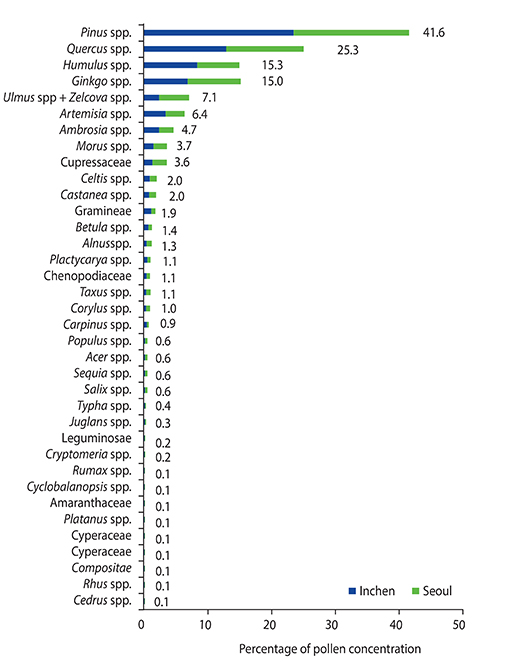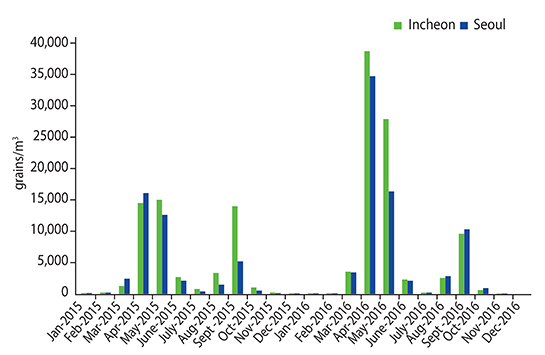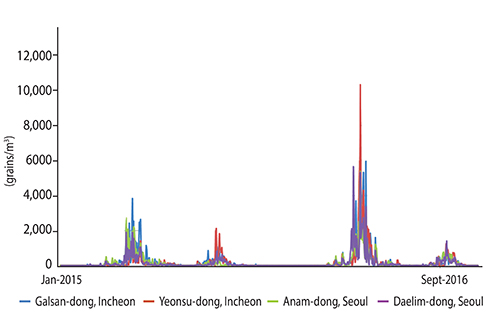Characteristics of airborne pollen in Incheon and Seoul (2015–2016)
- Affiliations
-
- 1The Environmental Health Center for Allergic Rhinitis, Inha University Hospital, Incheon 22332, Korea. dhyunlim@inha.ac.kr
- 2Department of Pediatrics, Inha University Hospital, Incheon 22332, Korea.
- 3The Environmental Health Center for Asthma, Korea University Anam Hospiral, Ansan 15355, Korea.
- 4Department of Pediatrics, Hallym University Kangnam Sacred Heart Hospital, Seoul 07441, Korea.
- KMID: 2396937
- DOI: http://doi.org/10.5415/apallergy.2017.7.3.138
Abstract
- BACKGROUND
Pollen allergens are one of the main contributors to the development and/or aggravation of allergic rhinitis, allergic conjunctivitis, and asthma.
OBJECTIVE
An examination of the airborne pollen in residential areas should be conducted to aid the diagnosis and treatment of allergic diseases.
METHODS
Airborne pollen samples were collected from 2 sites in Incheon and 2 in Seoul from 2015 to 2016.
RESULTS
The highest monthly concentration of airborne pollen was observed in May and September each year. Pollen from 32 families and 50 genera was identified over the 2 years; of these, Pinus spp. showed the highest pollen concentration (41.6%), followed by Quercus spp. (25.3%), and Humulus spp. (15.3%), the latter of which had the highest concentration among weed pollen. The total pollen concentration was significantly higher in Incheon than in Seoul (p = 0.001 in 2015, p < 0.001 in 2016) and higher in 2016 than in 2015. The concentrations of pollen from weed species (Cupressaceae, Humulus spp., Artemisia spp., Ambrosia spp., and Chenopodiaceae) and grass species (Gramineae) were significantly higher (p < 0.001) than those from tree species. Pollen was distributed from February to November. The first pollen identified in both regions in each year was Alnus spp. Overall, the total concentration of Quercus spp., Betula spp., Humulus spp., Artemisia spp., Ambrosia spp., and Chenopodiaceae pollen increased significantly over the 2 years.
CONCLUSION
Region-specific differences exist in the pollen of major allergenic plants. Continuous monitoring of pollen is thus essential for management of pollen-related allergic disorders in each region.
MeSH Terms
Figure
Cited by 4 articles
-
Allergenic Pollen Calendar in Korea Based on Probability Distribution Models and Up-to-Date Observations
Ju-Young Shin, Mae Ja Han, Changbum Cho, Kyu Rang Kim, Jong-Chul Ha, Jae-Won Oh
Allergy Asthma Immunol Res. 2020;12(2):259-273. doi: 10.4168/aair.2020.12.2.259.Tree Pollen Sensitization and Cross-Reaction of Children with Allergic Rhinitis or Asthma
Ye Jin Park, Yoon Ha Hwang
Kosin Med J. 2019;34(2):126-137. doi: 10.7180/kmj.2019.34.2.126.Aerobiology in Asian airway allergic diseases
Bernard Yu-Hor Thong
Asia Pac Allergy. 2017;7(3):119-120. doi: 10.5415/apallergy.2017.7.3.119.A study on the correlation between outbreak of allergic rhinitis and airborne pollen in September
Jong Seok Kim, ye Joo So, Jeong Hee Kim, Dae Hyun Lim
Allergy Asthma Respir Dis. 2019;7(4):192-198. doi: 10.4168/aard.2019.7.4.192.
Reference
-
1. Oh SK, Seong HU, Lim DH, Kim JH, Son BK, Kim HC, Lee JY, Leem JH. Relationship between air pollutants and prevalence of allergic disease/pulmonary function in students in Incheon. Pediatr Allergy Respir Dis. 2010; 20:264–276.2. Nilsson ST, Spieksm FM. Traveller's allergy service guide. Stockholm (Sweden): Palynological Laboratory, Swedish Museum of Natural History, and Fisons Sweden AB;1992.3. Lee SY, Park JS, Lee KS, Hong CH. Pollen allergy in children (ll): the significance of tree pollen as a causative allergen in children with allergic diseases. J Korean Pediatr Soc. 1998; 41:799–807.4. Suk KD, Nam SH. The airborne pollen gains and the correlation with number of patients and medicine prescribed for allergies in Kyungsan. J Korean Soc Hyg Sci. 2004; 10:143–153.5. Oh YC, Kim HA, Kang IJ, Cheong JT, Kim SW, Kook MH, Kim BS, Lee HB, Oh JW. Evaluation of the relationship between pollen count and the outbreak of allergic diseases. Pediatr Allergy Respir Dis. 2009; 19:354–364.6. Prentice IC. Pollen representation, source area, and basin size: toward a unified theory of pollen analysis. Quat Res. 1985; 23:76–86.
Article7. Romano B, Mincigrucci G, Frenguelli G, Bricchi E. Airborne pollen content in the atmosphere of central Italy (1982-1986). Experientia. 1988; 44:625–629.
Article8. Yasaka M, Kobayashi S, Takeuchi S, Tokuda S, Takiya M, Ohno Y. Prediction of birch airborne pollen counts by examining male catkin numbers in Hokkaido, northern Japan. Aerobiologia. 2009; 25:111–117.
Article9. Choi HS, Cho JS, Choo JH, Ko WK, Ahn HY. Allergic rhinitis to Japanese cedar in Cheju Island. Korean J Otolaryngol-Head Neck Surg. 1999; 42:1129–1133.10. Oh JW, Lee HR, Kim JS, Lee KI, Kang YJ, Kim SW, Kook MH, Kang HY, Kim JS, Lee MH, Lee HB, Kim KE, Pyun BY, Lee SI, Han MJ. Aerobiological study of pollen and mold in the 10 states of Korea. Pediatr Allergy Respir Dis. 2000; 10:22–33.11. Oh JW, Kang IJ, Kim SW, Kook MH, Kim BS, Shin KS, Hahn YS, Lee HB, Shon MH, Cheong JT, Lee HR, Kim KE. The correlation between increased sensitization rate to weeds in children and the annual increase in weed pollen in Korea. Pediatr Allergy Respir Dis. 2006; 16:114–121.12. Oh JW. Features and recent changes of airborne pollen in Korea. Korean J Asthma Allergy Clin Immunol. 2007; 27:1–7.13. Park KJ, Kim HA, Kim KR, Oh JW, Lee SY, Choi YJ. Characteristics of regional distribution of pollen concentration in Korean Peninsula. Korean J Agric For Meteorol. 2008; 10:167–176.
Article14. Oh JW. Development of pollen concentration prediction models. J Korean Med Assoc. 2009; 52:579–591.
Article15. Kim JH, Oh JW, Lee HB, Kim SW, Kang IJ, Kook MH, Kim BS, Park KS, Baek HS, Kim KR, Choi YJ. Changes in sensitization rate to weed allergens in children with increased weeds pollen counts in Seoul Metropolitan area. J Korean Med Sci. 2012; 27:350–355.
Article16. Oh JW, Lee HB, Kang IJ, Kim SW, Park KS, Kook MH, Kim BS, Baek HS, Kim JH, Kim JK, Lee DJ, Kim KR, Choi YJ. The revised edition of Korean calendar for allergenic pollens. Allergy Asthma Immunol Res. 2012; 4:5–11.
Article17. Sung MS, Park YJ, Park GH, Oh JW, Kim SW. The correlation between allergy sensitization rate in pediatric and aerobiological study for airborne pollen in Busan for 15 years. Allergy Asthma Respir Dis. 2014; 2:38–47.
Article18. Agashe SN, Caulton E. Aerobiology-Applications of airborne pollen studies in allergy. In : Agashe SN, Caulton E, editors. Pollen and spores: applications with special emphasis on aerobiology and allergy. Enfield (NH): Science Publishers;2009. p. 237–258.19. Jung IY, Choi KR. Relationship between airborne pollen concentrations and meteorological parameters in Ulsan, Korea. J Ecol Environ. 2013; 36:65–71.
Article
- Full Text Links
- Actions
-
Cited
- CITED
-
- Close
- Share
- Similar articles
-
- Characteristics and Distribution of Airborne Pollen and Mold
- A study on the correlation between outbreak of allergic rhinitis and airborne pollen in September
- Survey of the Airborne Pollens in Seoul, Korea
- Characteristics of allergic pollens and the recent increase of sensitization rate to weed pollen in childhood in Korea
- Survey of airborne pollens in Seoul, Korea






